



Imprint: Michael Stenov (composer), P.O. Box 9, A-4623 Gunskirchen, Austria, email
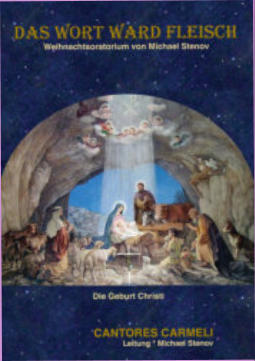
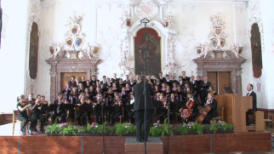
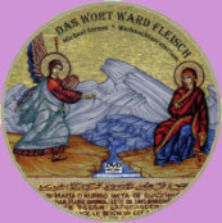
Visitors
Calls
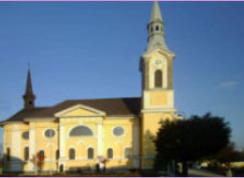
The
opening
chorus
with
the
text
from
the
Gospel
of
St.
John
lets
you
feel
the
mystery,
the
love
and
the
glory
of
the
Holy
Trinity
before
the
foundation
of
the
world
through
the
Word,
i.e.
Jesus
Christ
:
EVERYTHING
was
made
through
Him,
and
the
Triune
God,
who
is
the
light,
has
nothing
in
common
with
darkness.
Both
storylines
concerning
John
the
Baptist
and
Jesus
are
closely
interwoven.
Each
of
the
two
resulting
large
parts
Advent
and
Christmas
consists
of
four
smaller
parts,
which
are
finished
with
known
chorales.
The
Annunciation
,
the
long
waiting
and
finally
the
birth
of
first
precursor
John
and
finally
the
Saviour
and
Redeemer
Jesus
Christ
clearly
show
what
a
special
gift
of
God
an
innocent
child
in
the
world
has always been, is and will remain.
All
names
of
people
occurring
in
the
Christmas
story
have
a
special
meaning
in
Hebrew
(you
can
find
the
names
and
their
equivalents
in
the
booklet):
Zacharias
–
the
name
expresses:
„
Jahweh
remembers“
–
despite
the
message
of
the
Archangel
Gabriel
unable
to
believe
that
his
and
Elisabeth’s
intimate
prayers
for
a
child
are
still
heard
because
it
is
impossible
from
a
human
perspective;
Mary
(the
beloved),
however,
believes
the
in
her
case
much
more
incredible
word
of
the
angel,
although
she
does
not
understand
everything
immediately.
In
her
meeting
with
Elizabeth,
the
Holy
Spirit
fills
her
with
praise
of
God,
the
Magnificat
.
When
Zacharias
confirms
the
name
John
-
which
means
"God
has
shown
grace"
-
in
the
circumcision
of
his
son
and
thus
affirms
the
word
of
the
angel,
he
gets
back
his
ability
to
speak,
praises
God
in
the
Benedictus
full
of
the
Holy
Spirit
and prophesies great things to his child. All present marvel at the grace of God and his wonderful deeds.
The
real
Christmas
story
happens
in
the
second
part:
Jesus
,
after
the
fall
of
the
whole
sighing
and
in
labour
lying
creation
the
long
and
eagerly
awaited
saviour
of
mankind
from
eternal
death
and
destruction,
is
born
by
the
Virgin
Mary
in
Bethlehem.
Bethlehem
is
translated
"House
of
Bread",
which
already
points
to
Jesus
Christ
as
the
living
bread,
the
Eucharist
.
So
the
creator
of
the
universe
(the
Word
)
actually
comes
to
the
world
to
save
us
sinners
as
a
person
(in
the
flesh),
hidden
and
concealed
in
a
stable,
because
God
knows
that
the
highly
placed
of
his
people
would
not
accept
him
as
a
child
of
poor
people.
The
jubilant
chorus
of
angels
discloses
to
the
simple
people,
the
shepherds
that
the
Messiah,
the
Saviour,
is
born,
and
they
worship
him
as
representatives
of
the
Jewish
people.
In
the
presentation
in
the
temple
the
aged
priest
Simeon
confesses
him
as
the
Messiah
,
bringing
fulfilment
of
the
prophecy
that
he
will
see
the
saviour
of
the
world
before
his
death.
The
Hl.
Three
Kings
represent
the
acceptance
of
the
Messiah
by
the
Gentiles,
which
already
shows
that
Jesus
was
born
not
only
for
the
salvation
of
the
Jews
but
of
ALL
people.
The
chief
priests
and
Scribes
know
from
the
Torah
that
the
time
of
the
appearance
of
the
Messiah
is
here
and
refer
rightly
to
Bethlehem.
Herod
immediately
sees
his
power
as
ruler
threatened
and
had
have
murdered
all
the
boys
of
the
specified
age
by
the
three
kings
in
Bethlehem
so
as
to
kill
also
the
Chosen
Child,
that
-
warned
by
the
angel
-
succeeds
in
fleeing
to
Egypt
with
Joseph
and
his
mother,
Mary.
This
is
probably
a
bitter
foretaste
of
future
suffering
and
death
of
Jesus
himself
and
global
distress
and
persecution
of
many
professing
Christians
in
the
further
course
of
history.
In
the
last
choir
resonates
that
god's
plan
may be indeed disturbed by the
adversary
and mankind, but ultimately can not be prevented.
With
this
oratorio
,
I
wholeheartedly
wish
you
a
deep
spiritual
and
psychological
understanding
of
the
most
important
story
of
a
child's
birth
which
the world has ever experienced.
Michael Stenov
Both
PAL-
DVD
and
double
CD
contain
a
booklet
(24
resp.
28
pages)
with
an
introduction
to
the
subject,
the
entire
German
text
of
the
composition
and
an
epilogue
of
the
composer,
which
gives
an
insight
into
his
musical
world
of
thought,
also
detailing
the
instrumentation
and
a
glossary
of
Jewish
names
along
with
their
meaning.
For
the
two-
part TV interview
with Prof. Andreas Schnee and the
composer
about his work, see
GLORIA-TV
.
The recording took place in the Imperial Hall at
Kremsmünster on 24th of September, 2011. The
90-minute two-part work was filmed by the
Upper Austrian camera crew with Franz Gangl,
Anton Grabmann and Heinz Reitstätter.
Editor: Michael Stenov
Sound: Tonstudio Andreas Schwarzgruber.
NEW: A lot of Reviews!
To the CD-DVD-Shop! To the videos!
To the music! To the pictures!
The OTHER CHRISTMAS ORATORIO
on Double-CD, PAL-VD and Blu-ray-DVD!
SCORE (A4- resp. A3), Piano reduction,
choral score and parts material
have been published by
DANIEL KUNERT - BUCH & NOTE
in 2014! To the Shop!
In
addition
to
the
Orchestra
(members
of
the
Bruckner
Orchestra
Linz
and
others)
and
five
soloists
(Tanja
and
Daniela
Höfer
(PAL-
DVD/CD)
resp.
Regina
Riel
and
Michaela
Diermeier
(First
Performance)
,
Martin
Kiener
,
Joachim
Roth
and
Dr.
Bert
Brandstetter
)
a
large
choir
participated
in
the
work,
which
sees
itself
as
a
comprehensive
Christmas
synopsis
(
CANTORES
CARMELI
LINZ
).
Music
students
and
professors
mainly
from
Upper
Austria
formed
the
choir.
The
composer
himself
was
also
the
conductor of the recording and the first performance.
the
famous
Christmas
Oratorio
by
J.
S.
Bach.
It
shows
the
flow
of
the
Christmas
events
with
the
full
German
text
of
all
four
gospels
.
Michael
Stenov
,
therefore,
speaks
of
a
harmony
of
all
four
Gospels.
The
first
part
(ADVENT)
of
the
oratorio
starts
with
the
spiritual
interpretation
of
John
the
Evangelist and includes proclamation and birth of John the Baptist.
The
second
part
(CHRISTMAS)
turns
to
the
birth
of
Christ
and
illuminates
it
including
the
presentation in the temple, the visit of the Holy Magi and the flight of the Holy Family to Egypt.
in
the
Imperial
Hall
of
Kremsmünster
in
autumn
2011.
The
PUBLIC
PREMIERE
took
place
on
Sunday,
December
11,
2011,
at
19.30
in
the
Mühlviertler
Dom
(Parish
Niederkappel).
The
composer
used
biblical
texts
almost
exclusively
that
make
the
Christmas
story
more
a
full
experience,
as
it
is
the
case
with
The other Christmas Oratorio from Upper Austria
The
Upper
Austrian
composer
Michael
Stenov
wrote
a
great
Christmas
Oratorio
(90'),
entitled
"Das
Wort
ward
Fleisch
-
Die
Geburt
Christi”
(The
Word
became
flesh
-
The
Nativity)
Op
11
which
was
recorded
(without
audience)
for
a
PAL-
DVD
and
double
CD

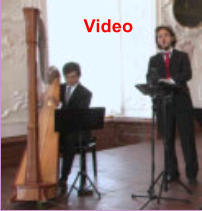
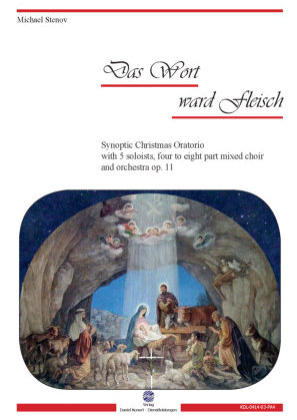
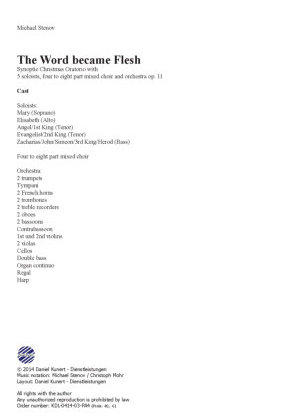
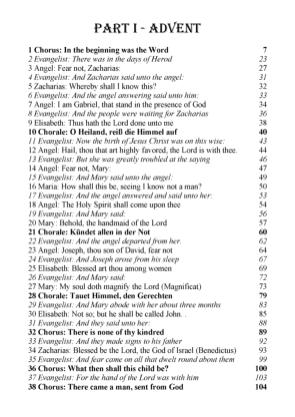
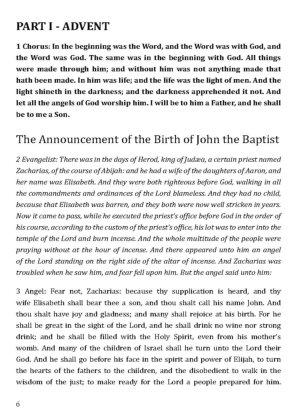
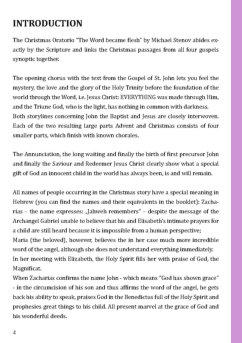
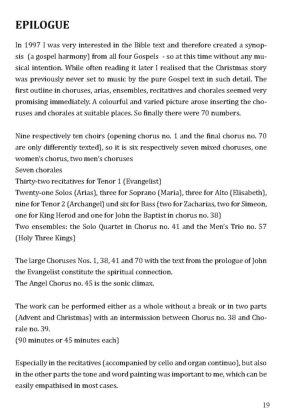
SCORE, piano reduction, choral score and parts material
(sheet music) was launched in 2014 by:
VERLAG DANIEL KUNERT - BUCH & NOTE
In 1997 I was very interested in the Bible text and therefore created a synopsis (a gospel
harmony) from all four Gospels - so at this time without any musical intention. While often
reading it later I realised that the Christmas story was previously never set to music by the pure
Gospel text in such detail. The first outline in choruses, arias, ensembles, recitatives and
chorales seemed very promising immediately. A colourful and varied picture arose inserting the
choruses and chorales at suitable places. So finally there were 70 numbers.
Nine resp ten choirs (opening chorus no. 1 and the final chorus no. 70 are only differently
texted), so it is six resp seven mixed choruses, one women's chorus, two men's choruses
Seven chorales
Thirty-two recitatives for Tenor 1 (Evangelist)
Twenty-one solos (Arias), three for Soprano (Mary), three for Alto (Elisabeth), nine for Tenor
2 (angel) und six for Bass (two for Zacharias, two for Simeon, one for King Herod and one
for John the Baptist in chorus no. 38)
Two ensembles: the Solo Quartet in chorus no. 41 and the Men’s Trio no. 57 (Holy Three
Kings)
The large choirs Nos. 1, 38, 41 and 70 with the text from the prologue of John the Evangelist
constitute the spiritual connection.
The angel chorus no. 45 is the sonic climax.
The work can be performed either as a whole without a break or in two parts (Advent and
Christmas) with an intermission between Chorus no. 38 and Chorale no. 39.
(90 minutes or 45 minutes each)
Especially in the recitatives (accompanied by cello and organ continuo), but also in the other
parts the tone and word painting was important to me, which can be easily empathised in most
cases. In composing the solo pieces, it seemed vital to tune the instrumentation, timbre and keys
to the characters or the text passages.
The whole of the first part up to and including chorus No. 38 tells the prehistory OF the birth
of Jesus; the smaller portions always culminate in a choral. (No. 1 - 10: The announcement
of the birth of John the Baptist, No. 11 - 21: The announcement of the birth of Jesus, No. 22 -
28 Mary’s Visitation to Elisabeth, No. 29 - 38 The birth of John the Baptist)
The first fugue subject of the opening chorus no. 1 returns into itself and therefore includes
audibly "everything" (respectively the "Heart of the Father" in the final chorus no. 70). The
second fugue subject is very flexible, therefore symbolises both lives in the opening chorus and
the Holy Spirit in the final chorus. The low a cappella-passage ends in a diminished seventh
chord (the darkness has not recognised the word - the „logos“, Christ). Instead of that, the angels
serve him, and Father and Son are one.
The two trumpets in the angel's pieces Nos. 3, 7 and 12 and the recitative no. 22 symbolise the
angel's wings, as the two French horns in the angel apparitions in the dreams of Joseph (no. 23,
64 and 68). Of course, it suits best to accompany with the harp; in this case without an "earthly"
bass instrument to indicate the celestial sphere.
The old Zacharias is accompanied by two bassoons underlined by the double bass as a continuo
instrument. The Benedictus - the canticle of Zechariah - is divided into two parts by an
instrumental interlude due to the length. (Nos. 5 and 34 in A Minor)
For Elisabeth I chose the Dorian key and two violas the violoncello as a bass instrument and for
the first time followed by also Dorian C
horale no. 10, whose second verse is a Bass-Cantus
firmus. (Nos. 9, 25 and 30)
For Maria, in the Magnificat two violins seemed best to support the oboe with the Gregorian
Magnificat-Cantus firmus. Since Mary occupies a position between heaven and earth, I have
decided for the Viola as "bass instrument" and the bass part deliberately kept in the range of the
viola. (No. 16 in D minor, no. 20 in C minor and no. 27 in F major)
Choral no. 21 has also got the melody in the bass in the second verse. In the chorales of the first
part, the obbligato instruments are oboe (Nos. 10 and 21) and French horns (no. 28) to express
the longing for the coming of the Messiah.
Both Turba Choruses no. 32 in D minor and no. 36 in A Minor are accompanied only with basso
continuo resp. two additional violins.
The chorus no. 38 in D major with the bass solo (John the Baptist) in the middle part concludes
the first part.
The real Christmas story takes place in the second part, which takes about the same length as
the first, although it has got fewer numbers.
(No. 39 - 49 The birth of Jesus, No. 50 - 55 The Presentation in the Temple, No. 56 - 62 The
visit of the Magi, No 63 - 70 The flight to Egypt)
I took the well-known setting of Michael Praetorius as opening chorale of the second part (no.
39) and extended it to instrumental parts.
The very first recitative no. 40 briefly portrays the Nativity.
This is followed by chorus no. 41 in D major, which interprets this salvation spiritually with the
words of John the Evangelist. The solo quartet in the middle section deals with the problem of
mankind who is either inclined to accept the offer of salvation or just unfortunately not.
In No. 43 in G major a magnificent Seraph with six wings (with 2 trumpets, horns and
trombones) appears to the shepherds and announces the birth of the Saviour to them, followed
by the Angelic Chorus No. 45 in D major, in which all groups of instruments - symbolising both
the ladder to heaven and the ascending and rising of small and large angels - accompany the
singing of the choir.
The three-part male chorus of shepherds no. 47 in D minor with the two treble recs (alternatively
possibly with two oboes) and the bassoon forms a strong contrast in its simplicity.
The Chorale No. 49 devotes itself - by the two horns somewhat reluctant - to the worship of the
Divine Child in the manger.
In the temple the aged Simeon (No. 51 in G minor and No. 53 in C minor) - his power of belief
is symbolised by two trombones - confirms Jesus to be the Messiah.
In choral No. 55, the Christmas spirit breaks through with trumpets and timpani and angels
singing Hallelujah.
In Trio no. 57 in D Minor I used the Judeo-Sephardic scale whereby the Magi phonetically strut
along as on ambling camels of an oriental caravan. In the end, the oboe and two bassoons play
around the soloists in Arab-heterophony manner.
First hesitantly and then more confident and finally triumphantly the choir of the chief priests
and scribes No. 59 in A Minor - majestically accompanied by horns and trombones - confirms
the birth of the Messiah in Bethlehem.
Comparatively, the appearance of King Herod No. 61 in D major with trumpets and tympani
seems superficial and hypocritical; the accompaniment ideally is accomplished by Regal (regalis
= Royal) and contrabassoon.
Choral No. 62 - the aforementioned setting by Praetorius - has got a new text and is an
expression of reverence and adoration of the three kings.
The angel's warning the Holy Family (no. 64 in C minor) is followed by the female chorus no.
66 in F minor, the shattering inconsolable lament of Jewish mothers after the murder of their
children by Herod in Bethlehem.
The angel's request to return to Israel (No. 68 in C major) is joined by the final and prophetical
recitative No. 69. The final chorus No. 70 - musically identical with the opening chorus except
the added harp, which symbolises heaven and earth having been touched by the birth of the
Savior - is a future outlook in the history of salvation and ensures the substantial unity.
Edt bei Lambach, February 2011
Michael Stenov
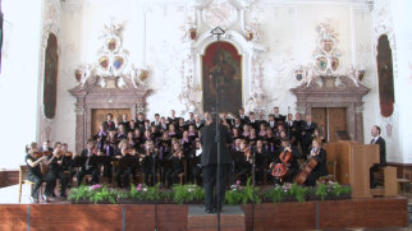
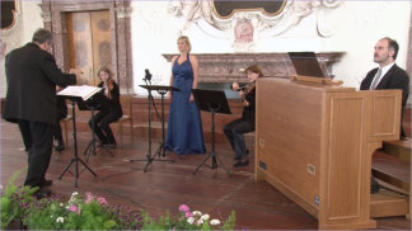
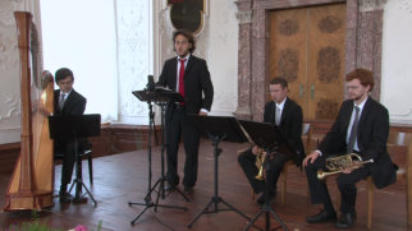
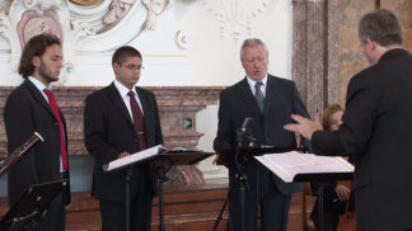
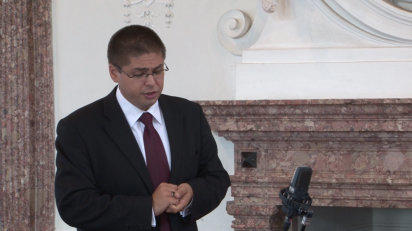
Video
Here you can listen to 5 of the 70 parts!
Total duration of the entire work: 90 minutes
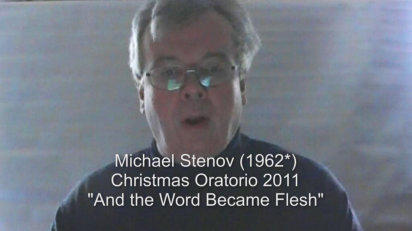
Short film 25‘





















